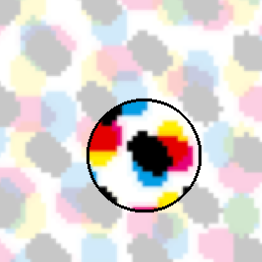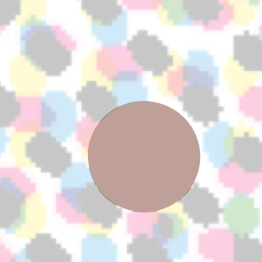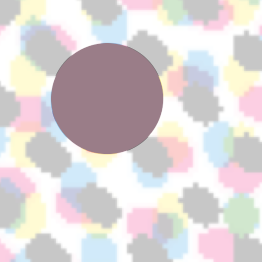Aperture • Screen Ruling • Patch Size
Select aperture based on a characteristic of the measured samples especially in the case of AM rasterized print it is a complex multicolor structure (rosette) built from CMYK RGB and White elements. Statistically, the selected aperture have to "see" enough elements that cropping will not affect results

Rasterized image (different screen ruling) always is transformed from continuous-tones to complex structure when we can see paper, primaries, and secondaries only. The instrument has to have an aperture big enough to mix this structure to the corresponding color tone.
Improper ratio aperture /screening ruling may produce unexpected results
For better understanding let's analyze the following example:
We have rasterized patch (part enlarged for demonstration purposes)

Lest select two aperture locations:
| A | B | |
 |
 |
|
| after averaging | ||
 |
 |
|
| L=68 a=10 b=9 | L=55 a=13 b=-2 | |
| ∆E76 = 17.3 | ||
This example is obviously exaggerated (the circle that represents aperture is very small compared to screen ruling), but it illustrates the need to statistically increase the number of samples
X-Rite is recommending selecting apertures correlated with parameters: Patch Size and Screen Ruling.
This table is a good guideline for most other instruments too.
| Aperture | Recommend Patch Size | Screening Ruling Range |
| 1.5 mm | 2-3 mm | 175 lpi / 69 l/cm or above |
| 2 mm | 3-5 mm | 133 lpi / 52 l/cm or above |
| 4 mm | 5-7 mm | 65 lpi / 26 l/cmn or above |
| 6 mm | 7 mm or larger |
Learn more.
Patch / Aperture Size requirements - X-Rite eXact
Contact ChromaChecker Support
Additional information and Support Form is available for logged users.